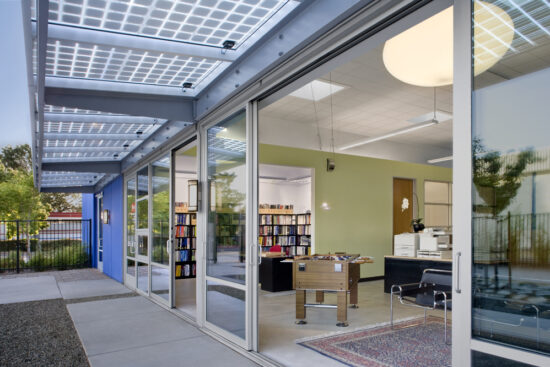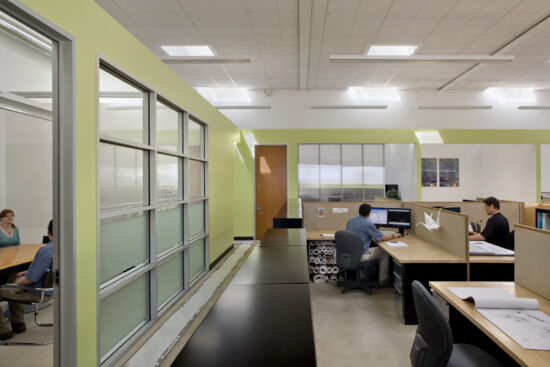Energy efficient building design has come a long way to improve building system energy performance. But what happens when the users move in? Additional equipment and appliances added after occupancy can dramatically impact actual building performance with surprising and expensive results.

Plug loads and process loads have been long considered outside the design team’s scope yet they can account for more than 1/3 of a building’s overall energy use. Net Zero Energy design, however, requires that all loads in a building be reduced. No client wants to increase the capacity of their costly solar PV array to cover energy usage generated by inefficient office equipment.

EHDD Architecture has completed four Net Zero buildings and currently has two in construction. In each of these projects, plug loads have proven to be a significant design consideration. As such, EHDD has conducted plug load studies of different projects to better determine the sources of these hidden loads and to develop strategies to reduce them. The studies uncovered some surprising truths about plug loads:
- The new home for San Francisco’s Exploratorium is aiming to be Net Zero Energy. Luckily for the design team, the existing exhibitions and office spaces provided an excellent opportunity to better understand the organization’s use of plug loads. The study found that a wealth of equipment, exhibits, and lighting were being left on all night, accounting for 37% of the facility’s plug load energy use. Through user education, plug load monitoring, better scheduling, and automatic timers, most of these loads will be drastically reduced or even eliminated.
- The Packard Foundation also had existing facilities that could be monitored during the design development phase of their new Net Zero Energy office building. The biggest surprise was the water coolers, which were found to account for 13% of plug load energy use. The study found that through a combination of purchasing policies, scheduling, and improved equipment efficiency, plug loads could be reduced by 58%, saving $820,000 on the cost of the PV system. For example, by purchasing the MOST efficient monitors instead of just settling for Energy Star rated monitors, they were able to reduce annual energy use for each monitor by 59% from 134 kWh to 56kWh.
- The Net Zero Energy office building for Integrated Design Engineers and Associates found that the server and computers accounted for a whopping 88% of the facility’s plug loads. The project contains extensive monitoring that will give detailed data on plug loads and overall energy performance and help guide plug load reduction strategies.
- Scott Shell, a Principal at EHDD Architecture, also conducted an extensive plug load study of his Net Zero Electrical home in Marin. He found that one of his biggest energy hogs was from equipment and appliances left on standby mode. These ‘phantom’ loads accounted for 26% of his plug loads, the worst being a built-in stereo system that had come with the house. He was able to eliminate most of these loads with power strips and thereby saving money on his solar PV system.
The plug load studies have revealed some easy to implement energy saving tips that we now suggest to every client:
- Establish a purchasing policy that specifies the best performing Energy Star and EPEAT certified equipment.
- Consider replacing older equipment and appliances with newer, more efficient versions. Energy Star and other resources have calculators to determine the financial benefits of an upgrade.
- Switch out all incandescent light bulbs to compact fluorescent lamps.
- Install occupancy sensor controlled plug load strips in each office/workstation and educate staff on proper use.
- Install automatic timers on things such as vending machines, copiers, coffee makers, water coolers etc. to turn off unused equipment after hours.
- Put all copiers and printers on standby modes.
- Use PC Power Management software over the local network such as those offered by Verdiem, Faronics Technologies, or Big Fix Inc. to power down computers when they are not in use.
- Use plug load meters to measure actual energy use of equipment and appliances. You may be surprised by what you discover!


Resources:
- www.energystar.gov (for efficient appliances and equipment). You can SORT the list of energy star products in the Excel format to find the MOST efficient appliance in each category.
- http://www.toptenusa.org/ (a shorter list of the top 10 efficient Energy Star products in different categories)
- Efficientproducts.org (electronics)
- www.80plus.org (computers, servers etc)
- www.wattstopper.com (power strips, controls, occupancy sensors etc)
- www.verdiem.com (PC Power Management
- www.epeat.net (environmental rating of electronics)
- www.greenpeace.org/international/campaigns/toxics/electronics/how-the-companies-line-up (Greenpeace Guide to Greener Electronics)
- www.p3international.com/products/special/P4400/P4400-CE.html (Kill-A-Watt plug load meter)





loved this post.
Effects of environmental degradation.
Thinking green is the way to a better future!